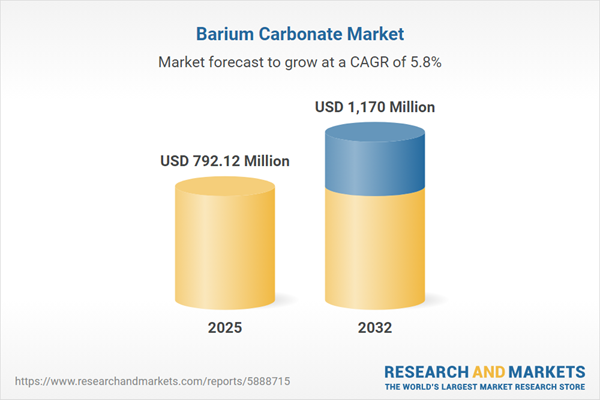Speak directly to the analyst to clarify any post sales queries you may have.
Barium carbonate plays an essential role across multiple manufacturing sectors, enabling product performance at the intersection of ceramics, electronics, and specialty chemicals. As industry conditions evolve, executives must leverage timely insights to secure competitive advantage in the global barium carbonate market.
Market Snapshot: Barium Carbonate Market Size and Growth Outlook
The barium carbonate market is expanding, reaching USD 748.85 million in 2024 and forecasted to increase to USD 792.12 million in 2025, with a projected valuation of USD 1.17 billion by 2032. This represents a robust CAGR of 5.82%. Growth drivers include the rising integration of barium carbonate in advanced manufacturing, the pursuit of high-purity production processes, and strategic shifts in procurement. Demand is propelled by technology-intensive sectors, where manufacturers invest in scalable, efficient solutions. Evolving regulatory frameworks spur sustainability improvements and greater operational agility, which are now integral to ongoing success in the sector.
Barium Carbonate Market Scope & Segmentation
This detailed market scope outlines the primary categories influencing procurement decisions and opportunities for differentiation within the barium carbonate industry.
- Applications: Ceramics manufacturing, geothermal drilling and oilfield fluids, pyrotechnics, production of various glass types, and pigment production for inks, paints, coatings, and plastics. Each application sets specific requirements for technical properties and purity, emphasizing the necessity for tailored supply chains.
- End Use Sectors: Agriculture (animal feed additives, soil remediation), chemical synthesis (downstream barium compounds), electronics (including cathode ray tubes, phosphors), and oil and gas (with a focus on drilling fluids and cementation applications). These highlight the diverse range of critical use cases and specialized needs addressed by industry suppliers.
- Grades: Analytical, electronic, industrial, and technical grades each fulfill distinct customer objectives for quality, reliability, and process compatibility.
- Forms: Granular, pellet, powder, and prill options support manufacturers in adapting production lines and optimizing blending practices for different operating environments.
- Purity Levels: Segmented by above 98%, 96–98%, and below 96%, these allow buyers to align deliveries with precise technical specifications or cost structures.
- Geographical Focus: Americas (including the United States, Canada, Brazil), Europe, Middle East & Africa, and Asia-Pacific (such as China, India, Japan, Korea), reflecting both established and emerging sourcing trends impacting regional strategies.
- Key Companies Analyzed: Leading and specialist manufacturers including PVS Chemicals, Inc.; Nan Ao Chemical Group Co., Ltd.; Tianjin Kermel Chemical Reagent Co., Ltd.; Merck KGaA; Thermo Fisher Scientific Inc.; Sinopharm Chemical Reagent Co., Ltd.; and Brenntag AG.
Key Takeaways for Senior Decision-Makers
- Adopting digital monitoring and predictive analytics streamlines manufacturing, leading to improved quality control and sustained process efficiency.
- A reassessment of global supply chains in response to shifting trade dynamics is enabling firms to adopt diversified sourcing and reinforce resilience with strategic partnerships.
- Developments in regulatory and environmental policy are accelerating the move toward closed-loop manufacturing and advanced recycling to ensure compliance and control operating costs.
- Demand from sectors such as ceramics, energy, and specialty glass is emphasizing the need for targeted product development and responsive R&D.
- Ongoing collaboration between producers, research bodies, and licensors is easing the introduction of new materials and underpinning smoother regulatory transitions.
Tariff Impact: Navigating U.S. Trade Policy Changes
Recent U.S. tariffs on certain chemical imports are reshaping supply models for barium carbonate, compelling stakeholders dependent on imports to seek domestic alternatives and secure long-term procurement contracts. Suppliers from regions unaffected by tariffs are strengthening their position in global trade, driving diversification and more robust supply chains. These evolving dynamics demand enhanced negotiation skills and risk management measures in sourcing practices.
Methodology & Data Sources
Research findings are based on a blend of primary interviews, structured industry surveys, analysis of scientific publications, regulatory reviews, trade data, and patent research. Expert panels and scenario analyses were used to cross-validate all key insights, ensuring actionable intelligence for industry stakeholders.
Why This Report Matters
- Equips executives with the intelligence needed to steer technology investment and product strategy as regulations and market landscapes evolve.
- Enables optimization of procurement and supply chain operations to maintain business continuity in rapidly changing global markets.
- Delivers precise market segmentation, helping leaders prioritize opportunities for commercial growth and operational enhancements suited to regional or industry-specific needs.
Conclusion
Comprehensive market insights empower senior leaders to respond to changing market forces, foster productive collaborations, and drive innovation within the barium carbonate sector.
Additional Product Information:
- Purchase of this report includes 1 year online access with quarterly updates.
- This report can be updated on request. Please contact our Customer Experience team using the Ask a Question widget on our website.
Table of Contents
3. Executive Summary
4. Market Overview
7. Cumulative Impact of Artificial Intelligence 2025
Samples

LOADING...
Companies Mentioned
The key companies profiled in this Barium Carbonate market report include:- PVS Chemicals, Inc.
- Nan Ao Chemical Group Co., Ltd.
- Tianjin Kermel Chemical Reagent Co., Ltd.
- Merck KGaA
- Thermo Fisher Scientific Inc.
- Sinopharm Chemical Reagent Co., Ltd.
- Brenntag AG
Table Information
| Report Attribute | Details |
|---|---|
| No. of Pages | 192 |
| Published | October 2025 |
| Forecast Period | 2025 - 2032 |
| Estimated Market Value ( USD | $ 792.12 Million |
| Forecasted Market Value ( USD | $ 1170 Million |
| Compound Annual Growth Rate | 5.8% |
| Regions Covered | Global |
| No. of Companies Mentioned | 8 |









